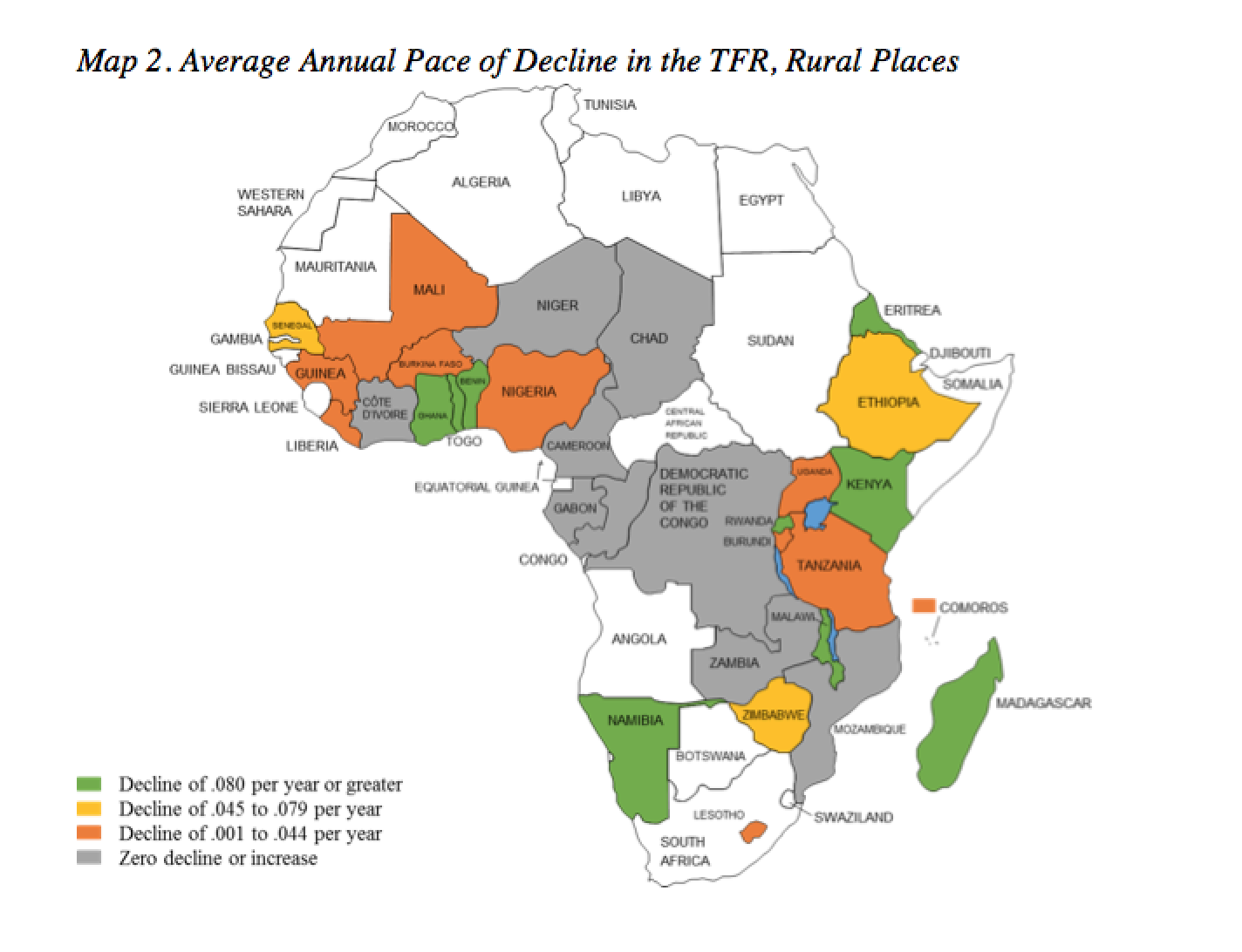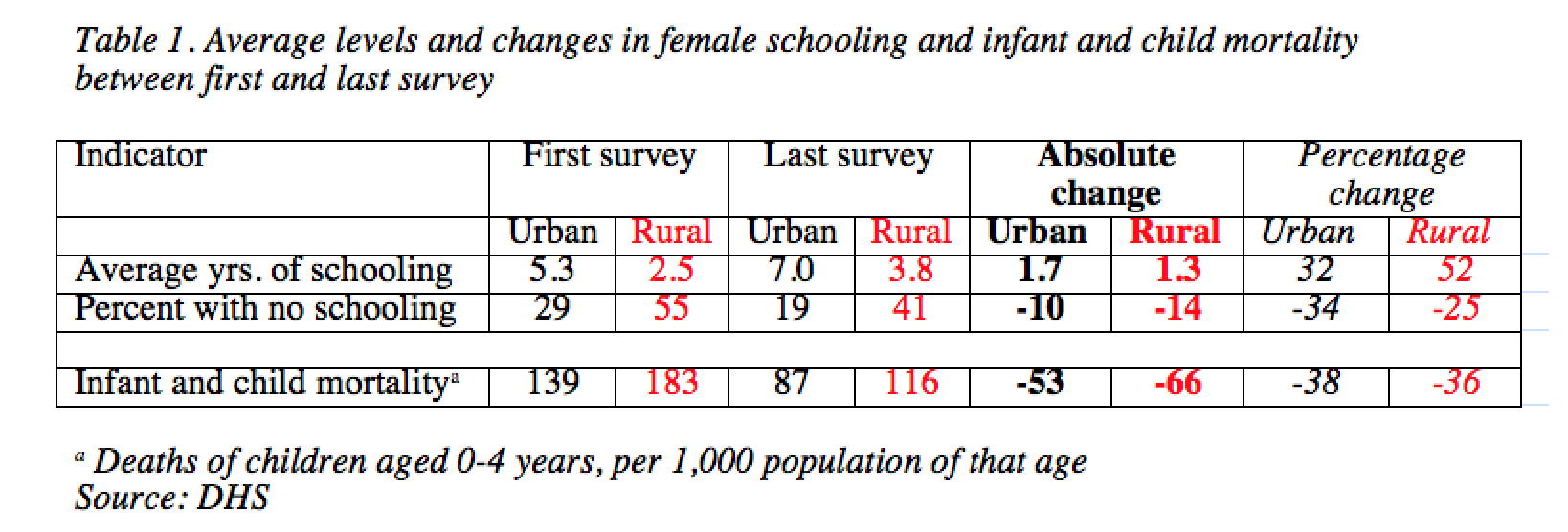Women’s schooling, child mortality, and fertility in Sub-Saharan Africa

Over time, women’s educational attainment in sub-Saharan Africa has been increasing (Barro and Lee, 2013), while infant and child mortality have been decreasing (United Nations, 2015). Both changes have contributed to the ongoing sub-Saharan fertility decline (Shapiro and Gebreselassie 2008; Shapiro 2012). Using micro data from 30 countries, all of which have had at least two Demographic and Health surveys, we seek to quantify the contributions of each of these changes. We use a statistical procedure that was originally developed for studying wage differences (Oaxaca 1973), but that has been applied to fertility change as well (Bundervoet, 2014). Here, a refined version of the procedure is used to estimate how much of the observed fertility decline may be attributed to increased education and how much reflects reduced mortality. We generate separate estimates for urban and rural places within each country. For details on the methodology and results by country, see Shapiro and Tenikue (2017)
Heterogeneity
Fertility is typically lower and has been declining more rapidly in urban than in rural areas. On average, the urban total fertility rate fell from just over 4.7 children per woman in the first survey to just under 3.9 in the last survey, a decline of 0.9 children or 19 percent. By contrast, in rural places the average TFR fell from just over 6.5 in the first survey to just under 6.0 in the last, a decline of 0.6 children or 9 percent. On average, the duration between the first and last survey was a little more than 16 years, but for individual countries it ranged from five to 27 years.
There was considerable heterogeneity in the experience of individual countries. Map 1 shows the average annual pace of decline of the urban total fertility rate, and Map 2 is the counterpart for rural places. Middle Africa typically displays slow declines or even increases in urban fertility. In rural areas, fertility declines are rare and slow, especially in Middle Africa. In Western and Eastern Africa there is more heterogeneity in rural fertility, with countries where it remains high, and others with relatively rapid declines.
Table 1 shows how educational attainment and infant and child mortality have changed in the countries analyzed; the table gives the average number of years of schooling and the percentage of women with no schooling, as well as the average infant and child mortality rate, as of the first and last DHS, for urban and rural places. Absolute and percentage changes in these indicators are also provided. Urban places had greater schooling and lower mortality as of the first survey, and absolute increases in years of schooling between the first and last survey were larger for urban places. By contrast, absolute declines in mortality were somewhat greater in rural areas.
The effect of female education and child mortality on fertility
Multivariate analyses reported in Shapiro and Tenikue (2017) show that in both urban and rural places, fertility declines with education, across six detailed categories that correspond roughly to no schooling, primary, low, medium, and upper secondary, and post-secondary. The declines are especially large for the two highest schooling groups. In addition, mortality at very young ages is positively related to fertility, presumably reflecting replacement fertility and insurance fertility.
For each country and place of residence, changes in educational attainment and in mortality are evaluated for their impact on fertility. These evaluations examine places in which fertility declined by more than a trivial amount, representing 26 of the 30 countries in the case of urban places, and – reflecting the lesser prevalence of rural fertility decline – only 15 of the rural places. As a consequence of differences between countries and by place of residence in rates of increase of schooling and rates of decrease of mortality, there was considerable variation among the countries in the results (Shapiro and Tenikue, 2017). In some cases, increased schooling was the major contributor to fertility decline, in others reduced mortality was distinctly more important, and in still others both factors were pertinent.
In urban places, increased women’s schooling accounted for an average of 57 percent of the observed declines in fertility, while reductions in infant and child mortality accounted for an average of 29 percent. In rural places where fertility declined, increased women’s schooling accounted for an average of 30 percent of the decline, while declining mortality accounted for an average of 36 percent. In both cases, the estimated contribution of schooling is a lower bound, since there is also an indirect effect of greater schooling in reducing infant and child mortality. In all cases, this analysis of individual data thus confirms earlier analyses of aggregate data, indicating that both increased women’s schooling and reduced infant and child mortality are important factors contributing to fertility decline in sub-Saharan Africa.
Policy implications
There are a few implications of interest in our findings. The longer-term trends toward increased schooling and reduced infant and child mortality suggest that fertility decline in the region will be ongoing; accelerating the increase of women’s schooling and improving delivery of public health services to reduce mortality more rapidly would presumably accelerate fertility decline. Continuing urbanization will also contribute to the ongoing decrease.
The United Nations (2015) estimate of fertility in sub-Saharan Africa by mid-century is approximately three children per woman. While this is well below the current level, it is expected to be associated with population growth of close to two percent annually. Challenges in educating growing populations and promoting economic growth and development will thus persist through much of this century. At the same time, improved opportunities for schooling and greater access to modern contraception, especially in rural places, have the potential to accelerate fertility decline in the coming decades.
References
Barro, Robert J. and Jhong Wa Lee. 2013. “A new data set of educational attainment in the world, 1950-2010.” Journal of Development Economics, (104): 184-198.
Bundervoet, Tom. 2014. “What explains Rwanda’s drop in fertility between 2005 and 2010?” Policy Research Working Paper no. WPS 6741. Washington, D.C.: World Bank Group.
Oaxaca, Ronald. 1973. “Male-female Wage Differentials in Urban Labor Markets.” International Economic Review, 14(3): 693-709.
Shapiro, David. 2012. “Women’s Education and Fertility Transition in Sub-Saharan Africa.” Vienna Yearbook of Population Research 2012, vol. 10: 9-30.
Shapiro, David and Tesfayi Gebreselassie. 2008. “Fertility Transition in Sub-Saharan Africa: Falling and Stalling.” African Population Studies, 23(1): 3-23.
Shapiro, David and Michel Tenikue. 2017. “Women’s Education, Infant and Child Mortality, and Fertility Decline in Urban and Rural Sub-Saharan Africa.” Demographic Research 37(21).
United Nations, Department of Economic and Social Affairs, Population Division. 2015. World Population Prospects: The 2015 Revision, DVD edition.


